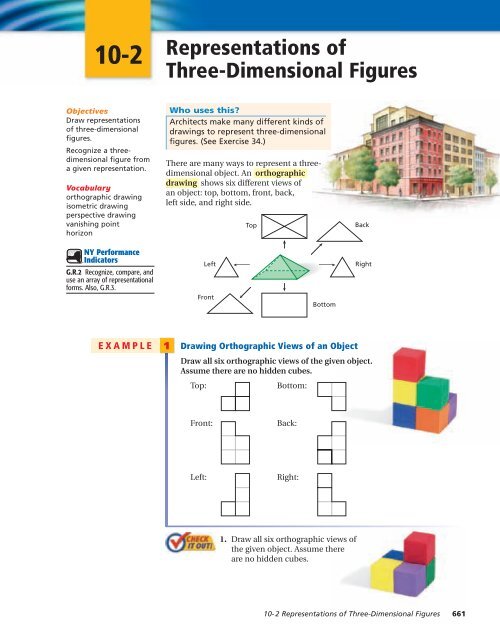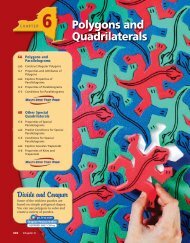Spatial Reasoning
Chapter 10 Spatial Reasonin - 30-Minute Websites for Teachers ...
Chapter 10 Spatial Reasonin - 30-Minute Websites for Teachers ...
- No tags were found...
Create successful ePaper yourself
Turn your PDF publications into a flip-book with our unique Google optimized e-Paper software.
10-2<br />
Representations of<br />
Three-Dimensional Figures<br />
Objectives<br />
Draw representations<br />
of three-dimensional<br />
figures.<br />
Recognize a threedimensional<br />
figure from<br />
a given representation.<br />
Vocabulary<br />
orthographic drawing<br />
isometric drawing<br />
perspective drawing<br />
vanishing point<br />
horizon<br />
Who uses this?<br />
Architects make many different kinds of<br />
drawings to represent three-dimensional<br />
figures. (See Exercise 34.)<br />
There are many ways to represent a threedimensional<br />
object. An orthographic<br />
drawing shows six different views of<br />
an object: top, bottom, front, back,<br />
left side, and right side.<br />
<br />
<br />
NY Performance<br />
Indicators<br />
G.R.2 Recognize, compare, and<br />
use an array of representational<br />
forms. Also, G.R.3.<br />
<br />
<br />
<br />
<br />
EXAMPLE 1 Drawing Orthographic Views of an Object<br />
Draw all six orthographic views of the given object.<br />
Assume there are no hidden cubes.<br />
Top:<br />
Bottom:<br />
Front:<br />
Back:<br />
Left:<br />
Right:<br />
1. Draw all six orthographic views of<br />
the given object. Assume there<br />
are no hidden cubes.<br />
10- 2 Representations of Three-Dimensional Figures 661






